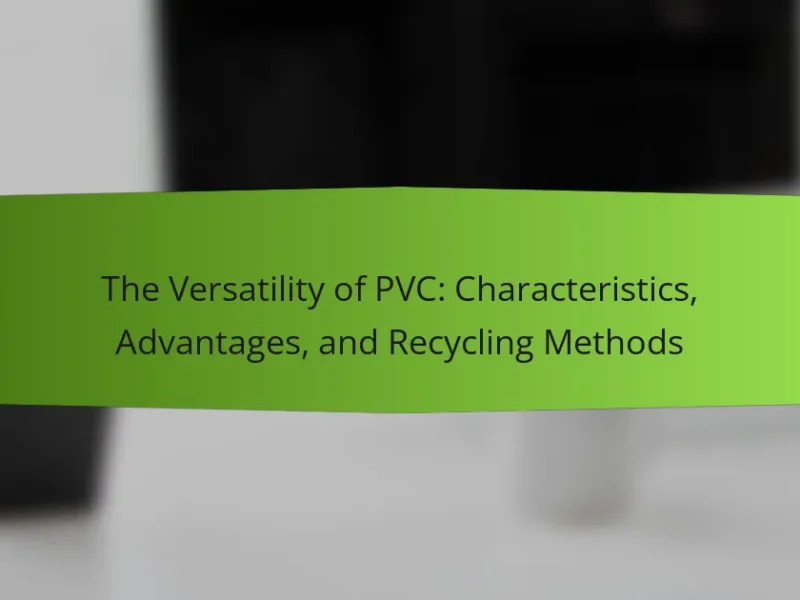Thermosetting plastics are a category of polymers that undergo an irreversible curing process when heated, resulting in a rigid and inflexible structure. Common types include epoxy, phenolic, and polyurethane resins, which are recognized for their high thermal stability and excellent mechanical properties. These materials are widely utilized in demanding applications, such as electrical insulators and automotive components, due to their durability, chemical resistance, and low shrinkage during curing. This article explores the properties, applications, and advantages of thermosetting plastics, providing insights into their effective use in various projects and environments.

What are Thermosetting Plastics?
Thermosetting plastics are a type of polymer that irreversibly cure when heated. This process creates a rigid structure that cannot be remolded or reshaped. Common examples include epoxy, phenolic, and polyurethane resins. Thermosetting plastics possess high thermal stability and excellent mechanical properties. They are widely used in applications requiring durability, such as electrical insulators and automotive components. The curing process typically involves a chemical reaction that forms cross-links between polymer chains. This results in a strong, inflexible material that withstands heat and chemical exposure.
How do Thermosetting Plastics differ from Thermoplastics?
Thermosetting plastics differ from thermoplastics primarily in their molecular structure and behavior during heating. Thermosetting plastics undergo a chemical change when heated, resulting in a hard, inflexible material that cannot be remolded. In contrast, thermoplastics soften upon heating and can be reshaped multiple times without altering their chemical structure.
Thermosetting plastics are typically used in applications requiring durability and heat resistance, such as electrical insulation and automotive parts. Thermoplastics are often favored for their versatility in manufacturing processes like injection molding and extrusion.
The distinction is crucial in material selection for specific applications. For example, epoxy resins are a common thermosetting plastic known for their strong adhesive properties. Polyethylene, a common thermoplastic, is widely used in packaging due to its flexibility and ease of processing.
What are the chemical structures of Thermosetting Plastics?
Thermosetting plastics are characterized by their irreversible curing process, forming a rigid structure. The chemical structure typically consists of cross-linked polymers. These polymers are formed through a chemical reaction, often involving heat or a curing agent. Common examples include epoxy resins, phenolic resins, and melamine-formaldehyde.
In epoxy resins, the structure includes epoxide groups that react with hardeners to create a three-dimensional network. Phenolic resins are derived from phenol and formaldehyde, forming a dense, cross-linked network upon curing. Melamine-formaldehyde resins consist of melamine and formaldehyde, leading to a strong, heat-resistant structure.
The cross-linking in thermosetting plastics provides enhanced mechanical strength and thermal stability. This structure prevents re-melting, distinguishing them from thermoplastics. The unique chemical properties contribute to their widespread use in applications requiring durability and resistance to heat and chemicals.
Why are Thermosetting Plastics irreversible once cured?
Thermosetting plastics are irreversible once cured due to their cross-linked molecular structure. During the curing process, heat or chemical reactions cause the polymer chains to bond in a three-dimensional network. This network is stable and does not melt upon reheating. Unlike thermoplastics, which can be remolded, thermosetting plastics cannot be reshaped after curing. The cross-linking creates a rigid structure that enhances durability and heat resistance. This characteristic makes thermosetting plastics ideal for applications requiring high strength and thermal stability. The irreversible nature is a key reason they are used in electrical insulators and automotive parts.
What are the key properties of Thermosetting Plastics?
Thermosetting plastics are a type of polymer that solidify upon heating and cannot be remolded. They exhibit high thermal stability and resistance to deformation under heat. These plastics are characterized by their strong cross-linking of polymer chains, which enhances their mechanical strength. They are also resistant to solvents and chemicals, making them suitable for various applications. Additionally, thermosetting plastics have excellent electrical insulation properties. Their rigidity and durability make them ideal for use in high-performance applications, such as automotive and aerospace components. The irreversible curing process during manufacturing contributes to their long-lasting properties.
How does heat resistance impact the use of Thermosetting Plastics?
Heat resistance significantly enhances the use of thermosetting plastics. These materials can withstand high temperatures without deforming. This property makes them suitable for applications in automotive and aerospace industries. For instance, thermosetting plastics are used in engine components due to their ability to resist thermal degradation. They maintain structural integrity under extreme heat, unlike thermoplastics. Additionally, their heat resistance allows for better electrical insulation in electronic components. This characteristic expands their application range in high-performance environments. Overall, heat resistance is a critical factor in choosing thermosetting plastics for demanding applications.
What role does chemical resistance play in the advantages of Thermosetting Plastics?
Chemical resistance is a crucial advantage of thermosetting plastics. It allows these materials to withstand exposure to various chemicals without degrading. This resistance makes thermosetting plastics ideal for applications in harsh environments. For example, they are used in automotive and aerospace industries where chemical exposure is common. The cross-linked structure of thermosetting plastics contributes to their durability and stability. This structure prevents the absorption of solvents and corrosive substances. Studies show that thermosetting plastics maintain their integrity even after prolonged chemical exposure. This property enhances their longevity and reduces maintenance costs in industrial applications.
What are the common applications of Thermosetting Plastics?
Common applications of thermosetting plastics include electrical insulation, automotive parts, and kitchenware. These materials are widely used in electrical applications due to their excellent insulating properties. For instance, they can withstand high temperatures and resist electrical currents. In the automotive industry, thermosetting plastics are utilized for components like dashboards and bumpers. Their durability and resistance to heat make them ideal for these uses. Additionally, thermosetting plastics are often found in kitchenware, such as bakeware and utensils, because they can endure high temperatures without deforming. Their strength and stability under heat contribute to their popularity in various applications.
Which industries primarily utilize Thermosetting Plastics?
The primary industries that utilize thermosetting plastics include automotive, aerospace, electronics, and construction. In the automotive industry, thermosetting plastics are used for components like dashboards and electrical housings. Aerospace applications include parts that require high strength and heat resistance. The electronics industry employs these plastics for circuit boards and insulation materials. In construction, thermosetting plastics are used in adhesives and coatings. These industries benefit from the durability and thermal stability of thermosetting plastics.
How are Thermosetting Plastics used in electrical applications?
Thermosetting plastics are used in electrical applications due to their excellent thermal stability and electrical insulation properties. These materials can withstand high temperatures without deforming. They are commonly used for circuit boards, connectors, and insulators. The high dielectric strength of thermosetting plastics prevents electrical conductivity. Additionally, they resist chemical damage, making them suitable for harsh environments. For instance, epoxy resins are often utilized in encapsulating electronic components. This encapsulation protects against moisture and mechanical stress. Thermosetting plastics also provide structural integrity in electrical housings. Their durability ensures long-lasting performance in electrical systems.

What advantages do Thermosetting Plastics offer?
Thermosetting plastics offer several advantages, including high thermal stability. They maintain their shape and strength at elevated temperatures. This makes them suitable for applications that involve heat exposure. Thermosetting plastics also exhibit excellent chemical resistance. They withstand solvents, acids, and bases without degrading. Their rigidity contributes to durability in various environments. Additionally, they have low shrinkage during curing, ensuring dimensional stability. These properties make thermosetting plastics ideal for automotive and electrical applications.
How do Thermosetting Plastics contribute to sustainability?
Thermosetting plastics contribute to sustainability through their durability and recyclability. These materials are designed to maintain their shape and strength under heat, reducing the need for frequent replacements. Their long lifespan minimizes waste and resource consumption. Additionally, thermosetting plastics can be repurposed at the end of their life cycle. This reduces landfill contributions and promotes a circular economy. Studies show that using thermosetting plastics can lead to lower carbon footprints compared to other materials. Their energy-efficient manufacturing processes further enhance their sustainability profile.
What are the durability benefits of using Thermosetting Plastics?
Thermosetting plastics offer significant durability benefits. They are known for their high resistance to heat and chemicals. This makes them ideal for applications in harsh environments. Thermosetting plastics do not melt or deform under heat, maintaining their shape. They also exhibit excellent mechanical strength and rigidity. These materials are less prone to cracking and chipping compared to thermoplastics. Additionally, thermosetting plastics have a longer lifespan due to their stable structure. Their durability enhances the reliability of products made from them in various industries.
How do Thermosetting Plastics enhance product performance?
Thermosetting plastics enhance product performance through their superior mechanical strength and thermal stability. These materials undergo a chemical change when cured, creating a rigid structure. This rigidity contributes to their ability to withstand high temperatures without deforming. Additionally, thermosetting plastics exhibit excellent resistance to chemicals and solvents. This makes them ideal for applications in harsh environments. Their dimensional stability ensures that products maintain their shape over time. Furthermore, they are less prone to warping compared to thermoplastics. These attributes result in longer-lasting and more reliable products across various industries.
What challenges are associated with Thermosetting Plastics?
Thermosetting plastics face several challenges. One major challenge is their brittleness, which can lead to cracking under stress. They also have limited recyclability due to their permanent setting nature. This makes disposal difficult and environmentally concerning. Additionally, thermosetting plastics typically require longer curing times compared to thermoplastics. This can slow down production processes. Furthermore, they are often more expensive to manufacture. The high costs can limit their use in certain applications. Finally, thermosetting plastics can be difficult to process due to their rigidity after curing. These challenges hinder their widespread adoption in some industries.
What are the limitations in recycling Thermosetting Plastics?
Thermosetting plastics have significant limitations in recycling. They undergo a chemical change during curing, making them rigid and infusible. This transformation prevents them from being melted down and reshaped like thermoplastics. The cross-linked structure of thermosetting plastics is stable, which complicates their breakdown into reusable materials. Additionally, the recycling processes for thermosetting plastics are not as developed or widely implemented as those for thermoplastics. Consequently, most thermosetting plastics end up in landfills. According to the American Chemistry Council, less than 5% of thermosetting plastics are currently recycled. This low recycling rate highlights the challenges and inefficiencies in recycling these materials.
How can manufacturers overcome processing challenges with Thermosetting Plastics?
Manufacturers can overcome processing challenges with thermosetting plastics by optimizing formulation and processing techniques. Adjusting the resin composition can enhance flow and reduce viscosity during processing. Utilizing advanced molding techniques, such as injection molding, can improve material distribution and reduce defects. Implementing precise temperature control during curing ensures consistent material properties. Additionally, using additives can enhance performance and processing characteristics. For example, fillers can improve mechanical strength and reduce shrinkage. These strategies can lead to more efficient processing and higher-quality finished products.

How can you effectively use Thermosetting Plastics in projects?
To effectively use thermosetting plastics in projects, select the appropriate type based on project requirements. Thermosetting plastics, such as epoxy, phenolic, and polyurethane, are known for their durability and heat resistance. Ensure proper mixing and curing processes are followed to achieve optimal performance. Utilize molds for shaping, as thermosetting plastics cannot be reshaped once cured. Consider the application environment, as some thermosetting plastics are better suited for high-temperature or chemical-resistant applications. Finally, conduct testing to validate the material’s performance under expected operating conditions. This approach ensures the successful integration of thermosetting plastics in various projects.
What best practices should be followed when working with Thermosetting Plastics?
When working with thermosetting plastics, it is essential to follow specific best practices. First, ensure proper mixing of components to achieve uniformity. Inadequate mixing can lead to inconsistencies in the final product. Second, maintain appropriate temperature control during the curing process. This ensures optimal cross-linking of the polymer chains, enhancing the material’s strength. Third, use protective equipment, as thermosetting plastics can emit harmful fumes during curing. Fourth, follow manufacturer guidelines for curing times and temperatures. This helps to achieve the desired material properties. Additionally, avoid contamination of the resin and hardener, as impurities can compromise the integrity of the final product. Lastly, store materials in a cool, dry place to prevent premature curing or degradation. These practices are supported by industry standards in composite manufacturing, emphasizing the importance of precision in processing thermosetting plastics.
How can you ensure optimal curing of Thermosetting Plastics?
To ensure optimal curing of thermosetting plastics, control temperature and time precisely. The curing process typically requires specific temperature ranges, often between 150°C to 200°C. Maintaining this temperature consistently allows the resin to cross-link effectively. Additionally, the curing time must align with the manufacturer’s specifications, which can range from minutes to hours.
Using an appropriate curing agent or hardener is also crucial. This agent initiates the curing reaction and must match the resin type used. Proper mixing of the resin and hardener ensures uniform distribution, promoting consistent curing throughout the material.
Finally, monitoring the environmental conditions, such as humidity and airflow, can impact the curing process. High humidity may lead to moisture absorption, affecting the final properties of the plastic.
These factors collectively contribute to achieving optimal curing, enhancing the performance and durability of thermosetting plastics.
What safety precautions should be taken when handling Thermosetting Plastics?
When handling thermosetting plastics, it is essential to wear appropriate personal protective equipment (PPE). This includes gloves, goggles, and respiratory protection to prevent skin and eye contact and inhalation of harmful fumes. Ensure proper ventilation in the workspace to minimize exposure to volatile organic compounds (VOCs) released during processing.
Employ safe handling techniques, such as using tools designed for thermosetting plastics to avoid injury. Follow manufacturer guidelines for temperature and pressure settings to prevent accidents during curing processes.
Regularly inspect work areas for spills or hazards, and clean up immediately to maintain a safe environment. Additionally, store thermosetting plastics in a cool, dry place away from direct sunlight to prevent degradation. These precautions align with safety standards set by organizations like OSHA and NIOSH, which emphasize the importance of minimizing risks associated with chemical exposure.
Thermosetting plastics are a type of polymer that undergoes irreversible curing when heated, resulting in a rigid structure with high thermal stability and excellent mechanical properties. This article explores the distinct characteristics of thermosetting plastics, including their differences from thermoplastics, chemical structures, and key properties such as heat and chemical resistance. It also covers common applications across various industries like automotive, aerospace, and electronics, while highlighting the advantages and challenges associated with their use, including durability, sustainability, and recycling limitations. Best practices for handling and processing thermosetting plastics are provided to ensure optimal performance in projects.


